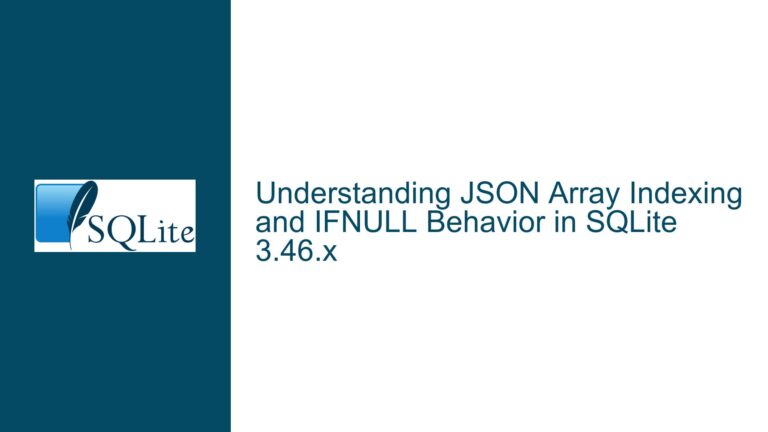SQLite PowerShell Output Issue: No Results from SELECT Query
Issue Overview: No Output from SELECT Query in SQLite via PowerShell
The core issue revolves around a user executing a series of SQLite commands and SQL scripts via PowerShell, expecting to see output from a SELECT query, but receiving no visible results. The user is running SQLite commands interactively in PowerShell, loading a database (boom.db), and executing an SQL script (init.sql). The script creates temporary tables, performs inserts, deletes, and calculations, and ends with a SELECT statement that should return a result. However, no output is displayed in the PowerShell terminal, leading to confusion about whether the operations are executing correctly.
The script involves creating temporary tables (_v, _v1, _v2, x202, x203), performing calculations based on data from a table named testroute, and finally executing a SELECT query to display the result of a subtraction operation between two aggregated values. The user expects to see the result of this SELECT query but observes no output, despite the script executing without apparent errors.
Possible Causes: Why No Output is Displayed
Missing or Empty
testrouteTable: The script relies heavily on the existence of a table namedtestroutewith specific columns (a1,d1,busnum). If this table does not exist or is empty, the calculations and inserts in the script will not produce any meaningful results. Specifically:- The
INSERT INTO _v1andINSERT INTO _v2statements depend on data fromtestroute. Iftestrouteis missing or empty, these inserts will not add any rows to_v1or_v2. - The subsequent calculations (
SELECT SUMoperations) will then operate on empty tables, resulting inNULLvalues.
- The
Temporary Tables with No Rows: The script creates temporary tables (
_v1,_v2,x202,x203) and performs operations on them. If the initial inserts into_v1and_v2fail (due to the absence oftestroutedata), these tables remain empty. As a result:- The
SELECT SUMoperations on_v1and_v2will returnNULLbecause there are no rows to aggregate. - The final
SELECTquery, which subtracts the results of these aggregates, will also returnNULL.
- The
PowerShell Output Configuration: The user explicitly sets
.output stdoutin the SQLite shell, which should direct query results to the standard output (the terminal). However, if the query result isNULL(as explained above), it may appear as if no output is being generated. Additionally, PowerShell’s handling of standard output streams (stdout, stderr) might obscure or suppress certain types of output.Script Execution Errors: While the script appears to execute without errors, there are potential issues that could prevent it from functioning as intended:
- The
testroutetable might not exist in theboom.dbdatabase. - The
init.sqlfile might contain syntax errors or logical flaws that prevent it from producing the expected results. - The
.readcommand might fail silently if the file path is incorrect or the file is inaccessible.
- The
Misunderstanding of SQLite Behavior: The user might expect the
SELECTquery to produce a visible result even when the underlying data is missing or invalid. However, SQLite will returnNULLfor operations involving empty tables or missing data, which might not be immediately visible in the terminal.
Troubleshooting Steps, Solutions & Fixes
Step 1: Verify the Existence and Content of the testroute Table
The first step is to ensure that the testroute table exists in the boom.db database and contains the necessary data. Open the SQLite shell and run the following commands:
.open boom.db
.tables
This will list all tables in the database. Verify that testroute is present. If it is not, create it and populate it with the required data. For example:
CREATE TABLE testroute (
a1 TEXT,
d1 TEXT,
busnum TEXT
);
INSERT INTO testroute (a1, d1, busnum) VALUES ('2023-01-01 12:00:00', '2023-01-01 13:00:00', '65');
If the table exists but is empty, insert sample data to ensure the script has something to work with.
Step 2: Debug the init.sql Script
To identify issues in the init.sql script, execute it step by step in the SQLite shell and observe the results. Start by opening the database and enabling echo to see each command as it is executed:
.open boom.db
.echo on
.read init.sql
This will display each command and its output, making it easier to pinpoint where the script fails or produces unexpected results. Pay particular attention to:
- The
INSERT INTO _v1andINSERT INTO _v2statements. If no rows are inserted, the issue likely lies with thetestroutetable or the join conditions. - The
SELECT SUMoperations. If these returnNULL, it indicates that the preceding inserts did not add any rows to_v1or_v2.
Step 3: Modify the Script to Handle Edge Cases
Update the init.sql script to handle cases where the testroute table is missing or empty. For example, add checks to ensure the table exists and contains data before performing operations:
-- Check if testroute exists and has rows
SELECT COUNT(*) FROM sqlite_master WHERE type='table' AND name='testroute';
SELECT COUNT(*) FROM testroute;
If the table is missing or empty, you can either create it dynamically or exit the script with an error message:
-- Exit if testroute is missing or empty
SELECT CASE
WHEN (SELECT COUNT(*) FROM sqlite_master WHERE type='table' AND name='testroute') = 0
THEN RAISE(FAIL, 'testroute table does not exist')
WHEN (SELECT COUNT(*) FROM testroute) = 0
THEN RAISE(FAIL, 'testroute table is empty')
ELSE 'OK'
END;
Step 4: Ensure Proper Output Handling in PowerShell
If the script is functioning correctly but no output is visible in PowerShell, verify that the .output stdout command is working as intended. Alternatively, redirect the output to a file and inspect it:
.output results.txt
.read init.sql
.output stdout
Open results.txt to see the query results. If the file is empty, the issue lies with the script or the data. If it contains the expected results, the problem is with PowerShell’s output handling.
Step 5: Test with a Simplified Script
To isolate the issue, create a simplified version of the script that performs only the essential operations. For example:
CREATE TEMP TABLE _v (id PRIMARY KEY, name TEXT, textvalue1 TEXT, textvalue2 TEXT);
CREATE TEMP TABLE _v1 (unixseconds INTEGER);
CREATE TEMP TABLE _v2 (unixseconds INTEGER);
-- Insert sample data into _v
INSERT INTO _v (id, name, textvalue1, textvalue2) VALUES (1, 'tk1', '2023-01-01 12:00:00', '2023-01-01 13:00:00');
-- Perform calculations
INSERT INTO _v1 SELECT unixepoch(coalesce(testroute.a1, _v.textvalue1)) - unixepoch(coalesce(testroute.d1, _v.textvalue2)) FROM _v, testroute WHERE (_v.name = 'tk1') AND (testroute.busnum = '65');
INSERT INTO _v2 SELECT unixepoch(coalesce(testroute.a1, _v.textvalue1)) - unixepoch(coalesce(testroute.d1, _v.textvalue2)) FROM _v, testroute WHERE (_v.name = 'tk2') AND (testroute.busnum = '65');
-- Aggregate and display results
CREATE TEMP TABLE x202 AS SELECT SUM(_v1.unixseconds) / 60 FROM _v1;
CREATE TEMP TABLE x203 AS SELECT SUM(_v2.unixseconds) / 60 FROM _v2;
SELECT ((SELECT * FROM x203) - (SELECT * FROM x202)) FROM x202, x203;
This simplified script avoids unnecessary complexity and makes it easier to identify the root cause of the issue.
Step 6: Consult SQLite Documentation and Community Resources
If the issue persists, consult the official SQLite documentation for guidance on temporary tables, aggregate functions, and output handling. Additionally, seek advice from the SQLite community or forums, providing a detailed description of the problem and the steps you have taken to troubleshoot it.
By following these steps, you should be able to resolve the issue of no output from the SELECT query in SQLite via PowerShell. The key is to verify the existence and content of the testroute table, debug the init.sql script, and ensure proper output handling in PowerShell.






